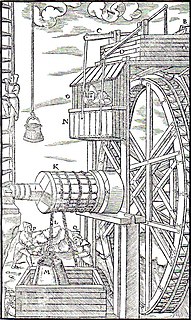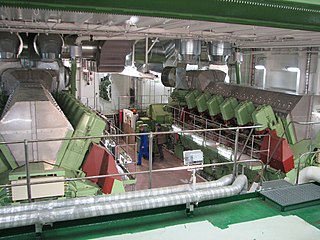Summary
As stated on the cover, the work is a survey of "Man's use of power, from the water wheel to the atomic pile." The topic is covered in short segments, titled "The Age of Engines," "Putting Energy to Work," "The First Engines," "Water and Wind Engines," "Early Steam Engines," "How a Steam Engine Works", "Steam Turbines," "Internal-combustion engines," "Otto Cycle Engines," "Two-stroke Cycle Engines," "Diesel Engines," "Gas Turbines," "Rockets," "Electric Motors," "How an Electric Motor Works," "Electric Generators and Power Systems," "Atomic Engines," and "How a Reactor Works." There is a brief one-page topical index.

An engine or motor is a machine designed to convert one form of energy into mechanical energy. Heat engines, like the internal combustion engine, burn a fuel to create heat which is then used to do work. Electric motors convert electrical energy into mechanical motion, pneumatic motors use compressed air, and clockwork motors in wind-up toys use elastic energy. In biological systems, molecular motors, like myosins in muscles, use chemical energy to create forces and ultimately motion.

A locomotive or engine is a rail transport vehicle that provides the motive power for a train. If a locomotive is capable of carrying a payload, it is usually rather referred to as a multiple unit, motor coach, railcar or power car; the use of these self-propelled vehicles is increasingly common for passenger trains, but rare for freight.

A steam engine is a heat engine that performs mechanical work using steam as its working fluid. The steam engine uses the force produced by steam pressure to push a piston back and forth inside a cylinder. This pushing force is transformed, by a connecting rod and flywheel, into rotational force for work. The term "steam engine" is generally applied only to reciprocating engines as just described, not to the steam turbine.

A vehicle is a machine that transports people or cargo. Vehicles include wagons, bicycles, motor vehicles, railed vehicles, watercraft, amphibious vehicles, aircraft and spacecraft.

A machine is a mechanical structure that uses power to apply forces and control movement to perform an intended action. Machines can be driven by animals and people, by natural forces such as wind and water, and by chemical, thermal, or electrical power, and include a system of mechanisms that shape the actuator input to achieve a specific application of output forces and movement. They can also include computers and sensors that monitor performance and plan movement, often called mechanical systems.

A gas turbine, also called a combustion turbine, is a type of continuous and internal combustion engine. The main elements common to all gas turbine engines are:

Mechanization is the process of changing from working largely or exclusively by hand or with animals to doing that work with machinery. In an early engineering text a machine is defined as follows:
Every machine is constructed for the purpose of performing certain mechanical operations, each of which supposes the existence of two other things besides the machine in question, namely, a moving power, and an object subject to the operation, which may be termed the work to be done. Machines, in fact, are interposed between the power and the work, for the purpose of adapting the one to the other.

A power station, also referred to as a power plant and sometimes generating station or generating plant, is an industrial facility for the generation of electric power. Power stations are generally connected to an electrical grid.

The English Electric Company Limited was a British industrial manufacturer formed after the armistice of World War I by amalgamating five businesses which, during the war, had been making munitions, armaments and aeroplanes.
Electrification is the process of powering by electricity and, in many contexts, the introduction of such power by changing over from an earlier power source. The broad meaning of the term, such as in the history of technology, economic history, and economic development, usually applies to a region or national economy. Broadly speaking, electrification was the build-out of the electricity generation and electric power distribution systems that occurred in Britain, the United States, and other now-developed countries from the mid-1880s until around 1950 and is still in progress in rural areas in some developing countries. This included the transition in manufacturing from line shaft and belt drive using steam engines and water power to electric motors.

A hot air engine is any heat engine that uses the expansion and contraction of air under the influence of a temperature change to convert thermal energy into mechanical work. These engines may be based on a number of thermodynamic cycles encompassing both open cycle devices such as those of Sir George Cayley and John Ericsson and the closed cycle engine of Robert Stirling. Hot air engines are distinct from the better known internal combustion based engine and steam engine.

Turbomachinery, in mechanical engineering, describes machines that transfer energy between a rotor and a fluid, including both turbines and compressors. While a turbine transfers energy from a fluid to a rotor, a compressor transfers energy from a rotor to a fluid.
Ground propulsion is any mechanism for propelling solid bodies along the ground, usually for the purposes of transportation. The propulsion system often consists of a combination of an engine or motor, a gearbox and wheel and axles in standard applications.

This Timeline of heat engine technology describes how heat engines have been known since antiquity but have been made into increasingly useful devices since the 17th century as a better understanding of the processes involved was gained. They continue to be developed today.

Man and Power: the Story of Power from the Pyramids to the Atomic Age is a science book for children by L. Sprague de Camp, illustrated with documents and photographs, and with paintings by Alton S. Tobey, first published in hardcover by Golden Press in 1961.
An engine is a device that converts one form of energy into mechanical energy.

Marine propulsion is the mechanism or system used to generate thrust to move a ship or boat across water. While paddles and sails are still used on some smaller boats, most modern ships are propelled by mechanical systems consisting of an electric motor or engine turning a propeller, or less frequently, in pump-jets, an impeller. Marine engineering is the discipline concerned with the engineering design process of marine propulsion systems.

Various scientists and engineers contributed to the development of internal combustion engines. In 1791, John Barber developed a turbine. In 1794 Thomas Mead patented a gas engine. Also in 1794 Robert Street patented an internal combustion engine, which was also the first to use the liquid fuel (petroleum) and built an engine around that time. In 1798, John Stevens designed the first American internal combustion engine. In 1807, French engineers Nicéphore and Claude Niépce ran a prototype internal combustion engine, using controlled dust explosions, the Pyréolophore. This engine powered a boat on the Saône river, France. The same year, the Swiss engineer François Isaac de Rivaz built an internal combustion engine ignited by electric spark. In 1823, Samuel Brown patented the first internal combustion engine to be applied industrially, one of his engines pumped water on the Croydon Canal from 1830 to 1836. He also demonstrated a boat using his engine on the Thames in 1827, and an engine driven carriage in 1828.

An internal combustion engine (ICE) is a heat engine in which the combustion of a fuel occurs with an oxidizer in a combustion chamber that is an integral part of the working fluid flow circuit. In an internal combustion engine, the expansion of the high-temperature and high-pressure gases produced by combustion applies direct force to some component of the engine. The force is applied typically to pistons, turbine blades, rotor or a nozzle. This force moves the component over a distance, transforming chemical energy into useful work.
Wallace L. Minto had a passion for science at a very young age. For instance, at age 13, he and his father, Wallace Milton Minto, stock piled more than 50 tons of uranium rich ore in Sparta, NJ. He was also the first to split the uranium atom while still a teenager. This nearly created an atomic explosion in his family home. At age 16, Wallace synthesized radium and invented what is now known as "Scotchlite". He had a copyright on his own periodic chart which renamed all the elements.















